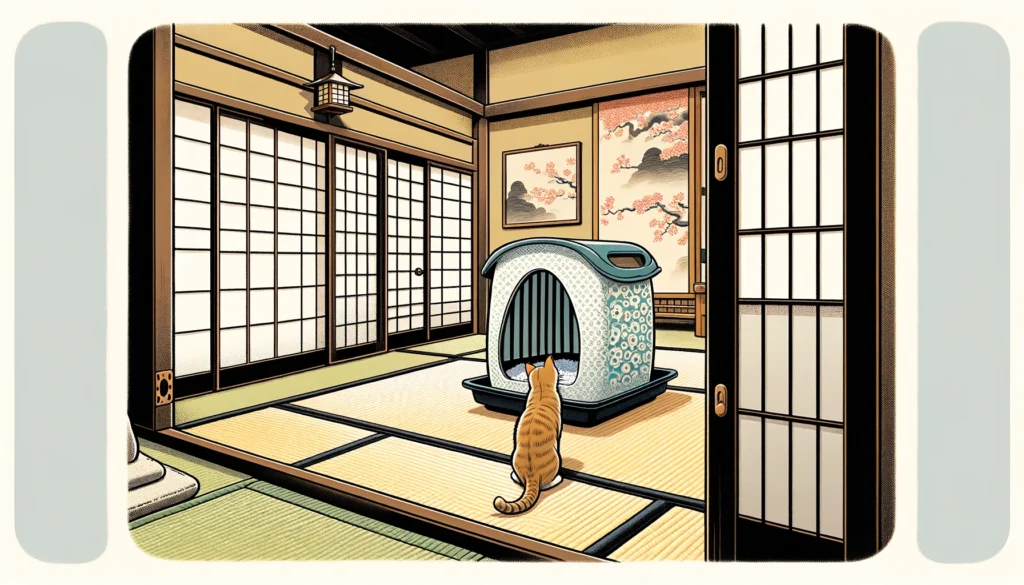Last updated on April 5th, 2024
Mastering how to transition your cat to covered litter box can redefine their comfort and privacy. When it comes to covered cat litter box’s, choosing the right type and transition techniques is key to your pet’s onboarding success.
Transitioning to a covered litter box enhances privacy and cleanliness for your cat, making their space a real hideaway. It’s not just a change for your cat, but a step forward for better hygiene and privacy that benefits both of you.
Quick tips for a smooth transition:
- Start by placing the new box close to the old one.
- Gradually introduce your cat to the new box with positive reinforcements.
- Keep the covered box clean and inviting to encourage use.
Key Takeaways: Mastering the Covered Litter Box Transition
- Understanding Your Cat: Recognize your cat’s habits and signs of readiness for a smoother transition.
- Choosing the Right Box: Ensure the new covered box suits your cat’s size and privacy needs.
- Step-by-Step Introduction: Gradually introduce your cat to the new box with familiar scents and positive reinforcement.
- Maintaining Cleanliness: Keep the litter box clean to encourage regular use and ensure a hygienic environment.
Why It Matters: Transitioning to a covered litter box can significantly improve your cat’s sense of security and your home’s cleanliness. But remember, every cat is different, and patience is key.

You may also like: Tips to Help Your Cat Adjust to a New Litter Box
Understanding Your Cat’s Needs
Recognizing Signs of Readiness
Identify if your cat is ready for a covered litter box by observing their current habits. Signs to watch for include:
- Seeking secluded spots during bathroom time.
- Litter being scattered outside their current open box.
- Showing discomfort or reluctance in open spaces.
Noticing these habits can indicate your cat’s readiness for more privacy.
Choosing the Right Covered Litter Box
Selecting the right enclosed litter box is critical for a smooth transition. Consider these factors:
- Size and shape that fit your cat’s body comfortably.
- Type of entrance – whether it’s on top or side, and if it’s easy for your cat to access.
- Enough internal space for your cat to move around without feeling cramped.
Picking a litter box that meets these criteria ensures your cat will have a safe and comfortable transition.

The Transition Process
Gradual Introduction
Slowly introduce your cat to their new hooded cat pan to build comfort and familiarity. Steps to take include:
- Initially placing the new box near the old one without removing the old box.
- Mixing some used litter from the old box into the new one to transfer scent.
- Allowing your cat to explore and sniff the new box at their own pace.
A gentle introduction can help your cat feel more comfortable with the change.
Positive Reinforcement Techniques
Encourage your cat’s use of the new box with treats and praise. Effective strategies include:
- Rewarding your cat with treats or affection each time they approach or use the new box.
- Maintaining a calm and positive environment around the new litter box area.
- Consistently using positive reinforcement to build a strong association between the box and good feelings.
Positive reinforcement can make the transition smoother and more pleasant for your cat.

Maintaining New Habits
Keeping the Box Appealing
Maintaining cleanliness is key to ensuring continued use of the enclosed cat litter box. Keep these points in mind:
- Clean the litter box regularly to prevent odors and buildup.
- Change the litter according to the product’s guidelines and your cat’s usage.
- Ensure the area around the litter box is quiet and safe, making it inviting for your cat.
A clean and welcoming environment encourages your cat to keep using the new litter box.
Monitoring Your Cat’s Adjustment
Watch your cat’s behavior closely to gauge their comfort and acceptance. Important aspects include:
- Observing if your cat uses the new box consistently and comfortably.
- Looking out for any signs of stress or avoidance related to the litter box.
- Being patient and ready to adjust factors like location or litter type if necessary.
Understanding your cat’s behavior and making necessary adjustments ensures a successful and lasting transition.

FAQ: Switching Your Cat to a Covered Litter Box
Q: How do you show your cat the new covered litter box?
A: Start by placing the new covered litter box next to the old one and let your cat explore it on their own. Use treats and praise to encourage them to enter and use the box.
Q: How can I make my cat start using a box with a roof?
A: Introduce your cat to the enclosed litter box gradually, keeping it clean and accessible. Reward them with treats or affection each time they use it.
Q: Are covered boxes cool for cats?
A: Many cats adjust well to covered litter boxes as they offer privacy and reduce odors, but individual preferences can vary.
Q: How do you teach a cat to go through a door flap to their litter?
A: Gradually train your cat to use a cat flap litter box by propping the flap open initially and enticing them with treats or toys.
Q: Why is my cat not into the new covered box?
A: Your cat might avoid a covered litter box if it’s too small, not cleaned enough, or if they had a bad experience. Observe their behavior and try to identify and address the issue.
Q: What type of litter boxes do cats like more, open or covered?
A: Some cats prefer open boxes for easy access, while others like the privacy of covered litter boxes. It often depends on the cat’s personal comfort and past experiences.
Q: Do cats really dislike hooded litter boxes?
A: Not all cats hate hooded litter boxes; it varies based on their personal preference and past experiences with litter boxes.
Q: Is it true that covered litter boxes are less stinky?
A: Covered cat litter boxes can help contain odors better than open ones, but they still need regular cleaning to prevent smells.
Further Reading
Covered or Uncovered Litter Boxes: Do Cats Really Care?

Conclusion: Embracing the Privacy
With the right approach, how to transition cat to covered litter box becomes a rewarding journey. Let’s wrap up with some key takeaways:
- Understand your cat’s preferences; every cat is unique.
- Take it step by step, don’t rush the process.
- Celebrate the wins, like the first time they use the new box.
How to transition cat to covered litter box isn’t just about a new piece of furniture; it’s about enhancing your cat’s comfort and your home’s hygiene. If you’ve found success, share your story or tips to help others! What will you try first to make this transition smooth for your furry friend?






